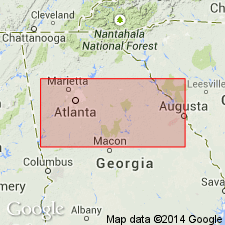
- Usage in publication:
-
- Lithonia granite-gneiss
- Modifications:
-
- Named
- Dominant lithology:
-
- Granite
- Gneiss
- AAPG geologic province:
-
- Piedmont-Blue Ridge province
Summary:
Name applied in this report to contorted granite-gneiss in vicinity of Lithonia.
Source: GNU records (USGS DDS-6; Reston GNULEX).
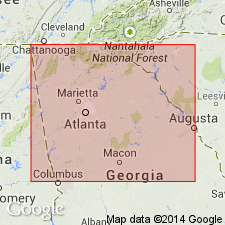
- Usage in publication:
-
- Lithonia granite
- Modifications:
-
- Revised
- AAPG geologic province:
-
- Piedmont-Blue Ridge province
Summary:
Toccoa Falls quartzite (Galpin, 1915) is a fine-grained phase of Lithonia granite.
Source: GNU records (USGS DDS-6; Reston GNULEX).
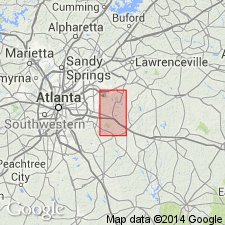
- Usage in publication:
-
- Lithonia gneiss
- Modifications:
-
- Revised
- Overview
- AAPG geologic province:
-
- Piedmont-Blue Ridge province
Summary:
Unit referred to in this report as Lithonia gneiss. Metamorphic rocks of this area are considered Precambrian. Lithonia gneiss was apparently migmatized during or shortly after final deformation of the metamorphic rocks. This deformation may have taken place in early stages of Appalachian Revolution. Intruded by Stone Mountain granite.
Source: GNU records (USGS DDS-6; Reston GNULEX).
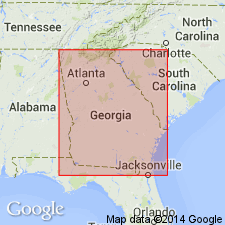
- Usage in publication:
-
- Lithonia granite
- Modifications:
-
- Geochronologic dating
- AAPG geologic province:
-
- Piedmont-Blue Ridge province
Summary:
Age determinations by isotope-dilution methods on zircon concentrations gave age of Lithonia granite as 425 to 485 m.y. These data are in contrast with K/A and Rb/Sr ages of 250-290 m.y. reported by previous workers. These older ages indicate a Late Cambrian(?) plutonic episode.
Source: GNU records (USGS DDS-6; Reston GNULEX).
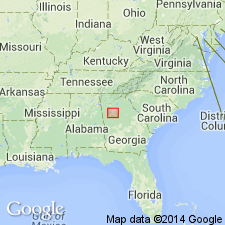
- Usage in publication:
-
- Lithonia Gneiss*
- Modifications:
-
- Age modified
- Geochronologic dating
- AAPG geologic province:
-
- Piedmont-Blue Ridge province
Summary:
Age shown in figure 1 as Proterozoic Y and (or) Proterozoic Z and (or) early Paleozoic. Exact age is uncertain. Preliminary radiometric ages of zircons in Lithonia Gneiss suggest an age of 375 m.y. (Higgins and others, unpub. data), but the data are still open for interpretation.
Source: GNU records (USGS DDS-6; Reston GNULEX).
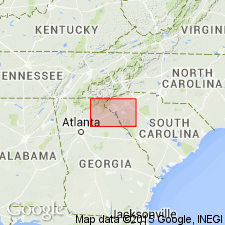
- Usage in publication:
-
- Lithonia Gneiss*
- Modifications:
-
- Overview
- AAPG geologic province:
-
- Piedmont-Blue Ridge province
Summary:
Rocks mapped as unnamed, undivided Devonian and Silurian granodiorite gneiss and granitic gneiss in Chauga-Walhalla thrust complex are equivalent, at least in part, to rocks mapped as Lithonia Gneiss in GA. These rocks have two preliminary concordant 207Pb-206Pb zircon ages at two locations of 419 Ma and 385 Ma (T.W. Stern and A.E. Nelson, unpub. data).
Source: GNU records (USGS DDS-6; Reston GNULEX).
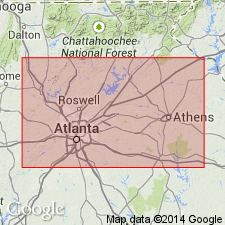
- Usage in publication:
-
- Lithonia Gneiss*
- Modifications:
-
- Revised
- Age modified
- AAPG geologic province:
-
- Piedmont-Blue Ridge province
Summary:
Although the name Arabia Mountain Migmatite was designated by Grant and others (1980) for a common variety of Lithonia Gneiss, in this report the rocks are informally named Arabia Mountain migmatite facies of Lithonia Gneiss. Rocks previously mapped as Norcross Gneiss are now thought to be a facies of Lithonia Gneiss; Norcross Gneiss is abandoned and its rocks assigned to Lithonia Gneiss. Recent geologic mapping, petrographic and geochemical studies, and some geochronological data of rocks called Lithonia Gneiss, Arabia Mountain migmatite facies within Lithonia Gneiss around Mount Arabia, "Odessadale Gneiss" in central GA (R.L. Atkins, unpub. mapping) and Farmville Metagranite of Opelika Complex in eastern AL have shown that 1) they are part of the same complex unit, 2) that several textural varieties are common to all of them in outcrop, 3) that they all occupy the same structural or stratigraphic interval, 4) that they have approximately the same mineral and chemical compositions, and 5) that their ages range between about 380 to 360 Ma (Middle to Late Devonian). Because of uncertainties in Pb-U zircon age data, because Rb-Sr and K-Ar ages could have been affected by metamorphism, and because overall sampling has been limited, all the gneisses are assigned an Ordovician to Devonian age although it is probably the age of the neosome; age of the paleosome of Lithonia Gneiss may be as old as Middle Proterozoic or as young as Middle Ordovician.
Source: GNU records (USGS DDS-6; Reston GNULEX).
For more information, please contact Nancy Stamm, Geologic Names Committee Secretary.
Asterisk (*) indicates published by U.S. Geological Survey authors.
"No current usage" (†) implies that a name has been abandoned or has fallen into disuse. Former usage and, if known, replacement name given in parentheses ( ).
Slash (/) indicates name conflicts with nomenclatural guidelines (CSN, 1933; ACSN, 1961, 1970; NACSN, 1983, 2005, 2021). May be explained within brackets ([ ]).

